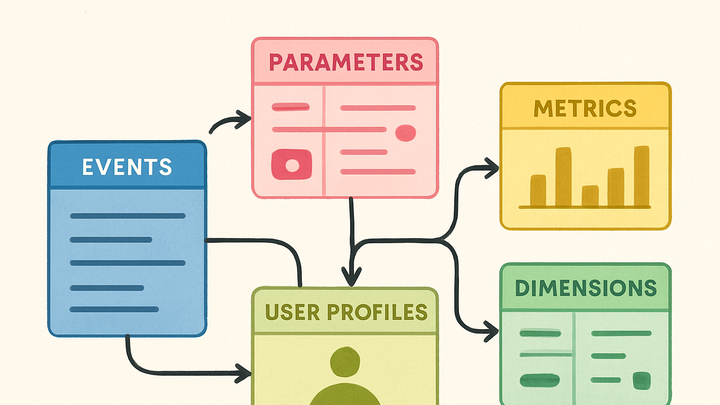Published on 2025-06-26T04:36:43Z
What is a Data Model? Examples and Importance in Analytics
An analytics data model is the formal structure that defines how raw interaction data is organized, stored, and interpreted to generate actionable insights. It specifies the schema for events (user interactions) and parameters (contextual details) as well as user identifiers, properties, metrics, and dimensions. A well-designed data model ensures consistency across reporting, simplifies cross-tool integrations, and enables precise audience segmentation. Different analytics platforms, such as Google Analytics 4 (GA4) and plainSignal, implement distinct data models that balance flexibility, performance, and privacy. For example, GA4 uses a flexible event-parameter model exportable to BigQuery with nested schemas, while plainSignal offers a streamlined, cookie-free schema optimized for lightweight tracking and privacy compliance. Understanding and applying best practices in data modeling is critical for maintaining data quality, scalability, and clarity in your analytics efforts.
Data model
A data model defines how analytics events, parameters, and user properties are structured and related for consistent, accurate reporting.
Core Concepts of an Analytics Data Model
An analytics data model is built around key building blocks—events, parameters, dimensions, metrics, and user identifiers. These components work together to capture user behavior, contextual information, and measurable outcomes. Having a clear understanding of each concept helps in designing a model that scales with business needs.
-
Events & parameters
Events represent user interactions such as page views, clicks, or purchases. Parameters provide context about these interactions, like button IDs or product SKUs.
-
Event schema
Define a consistent schema for events, including a name, timestamp, and parameters to capture context.
-
Naming conventions
Use descriptive, camelCase or snake_case for event names and parameters to ensure readability.
-
-
Dimensions & metrics
Dimensions are qualitative attributes that describe data (e.g., page URL), while metrics are quantitative values (e.g., event count). Combining them drives meaningful insights.
-
Dimensions
Qualitative attributes such as page location, device type, or user segment.
-
Metrics
Quantitative measures such as session duration, number of clicks, or revenue.
-
-
User identifier & properties
A unique user identifier (userID or clientID) ties events to individual users, while user properties store attributes like membership status or region.
-
Persistent id
Use a stable ID like userID for logged-in users or an anonymized clientID for guests.
-
User properties
Attributes such as plan type, signup date, or geographic location to segment analysis.
-
Data Modeling in GA4
Google Analytics 4 employs a flexible, event-centric data model where every interaction is captured as an event with up to 25 parameters. It also supports user properties and audiences for segmentation. GA4’s BigQuery export provides access to raw, nested event data for advanced analysis.
-
Event-centric model
In GA4, all interactions are recorded as events, each accompanied by parameters that add context.
-
Automatic events
GA4 tracks common events like first_visit, session_start, and screen_view without additional setup.
-
Custom events
Define business-specific events to capture interactions unique to your product.
-
-
User properties & audiences
User properties in GA4 let you attach persistent attributes to users, while audiences allow grouping users based on defined criteria.
-
User properties
Attributes such as user role or lifetime value that persist across sessions.
-
Audiences
Dynamic segments for analysis and remarketing, based on event sequences or user properties.
-
-
Bigquery export
GA4 can stream raw event data to BigQuery, preserving its nested JSON-like structure for advanced querying.
-
Nested schema
Events are stored with arrays of parameters and user_properties, allowing deep dives via SQL.
-
Custom queries
Write SQL to join, filter, and aggregate raw event data beyond GA4’s interface limitations.
-
Data Modeling in plainSignal
plainSignal is a lightweight, cookie-free analytics solution designed for privacy-first tracking. Its data model captures essential event fields while minimizing personal data storage and complexity.
-
Cookie-free tracking
plainSignal uses localStorage or fingerprinting to generate client identifiers instead of traditional cookies.
-
Privacy by design
No personal identifiable information is collected, and cross-site tracking is avoided.
-
Anonymized ids
Client identifiers rotate periodically to reduce long-term profiling.
-
-
Simple event schema
Each event includes core fields like event_name, url, referrer, and timestamp for streamlined analysis.
-
Limited parameters
plainSignal restricts custom parameters to ensure performance and clarity.
-
Minimal data retention
Data retention windows are short to comply with privacy regulations.
-
-
Implementation example
Insert plainSignal’s snippet to enable its data model on your site.
-
Tracking code example
<link rel="preconnect" href="//eu.plainsignal.com/" crossorigin /> <script defer data-do="yourwebsitedomain.com" data-id="0GQV1xmtzQQ" data-api="//eu.plainsignal.com" src="//cdn.plainsignal.com/plainsignal-min.js"></script>
-
Best Practices for Analytics Data Modeling
A robust data model enhances data quality, scalability, and cross-team collaboration. Following best practices helps maintain clarity and prevents schema sprawl as your analytics needs grow.
-
Establish clear schemas
Document event and parameter schemas in a centralized registry with version control.
-
Schema registry
Maintain a versioned registry of all events, parameters, and user properties.
-
Review process
Implement peer reviews for schema changes to avoid conflicts and redundancies.
-
-
Use consistent naming conventions
Adopt standardized naming (e.g., camelCase) across events and parameters for readability.
-
Convention guide
Publish guidelines detailing naming patterns and abbreviation policies.
-
Automated linting
Leverage tools to enforce naming rules in your analytics codebase.
-
-
Balance flexibility and structure
Allow some customization but cap the number of custom parameters to avoid analysis complexity.
-
Parameter limits
Define maximum parameter counts per event to keep schemas manageable.
-
Regular cleanup
Audit and remove unused events or parameters periodically.
-
